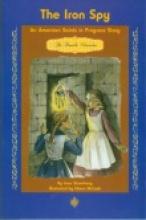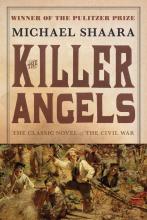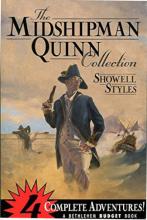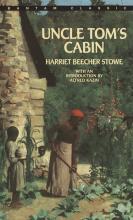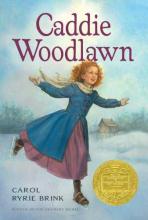19th century Historical Fiction
The Iron Spy
In this first book of the new series The Danville Chronicles, Joan Stromberg has found a fun and exciting way to teach faith to your children ten years and older. It will capture their imagination and keep their minds thinking.
This book takes place in the town of Danville, Pennsylvania in 1875. The biggest Iron Mill in town is owned by Mr. Graves. It has just exploded and Mary Mulhearn, an Irish immigrant, and her blind friend Kathleen Dodd are trying to find evidence that Mary's father, Mr. Mulhearn, is innocent of blowing up the Iron Mill and becoming a Molly Maguire. Although Mary's family knows he would never turn into a Molly Maguire and blow up the Iron Mill were he worked before it exploded, they also know that their realization of his innocence alone will not be enough to win the trial against Mr. Mulhearn.
Then one day, to make things more puzzling for Mary, a man who calls himself Sean McGinty shows up at Mary's door and says he is an immigrant right off a boat from Ireland and finds a place to stay at the Mulhearns' house. But Mary doesn't believe his story and is on his case. Mary and Kathleen go through adventures and trials, they find a detective book under a man's bed, they notice a ring that has shown up on two people, they spot a man in the town graveyard during the night, and they learn how to spy on a spy. They also have many more questions than answers at one point. Who is Sean really? Is he a Molly Maguire or is he on Mr. Graves' side? Who blew up the mill and why? If you want to know the answers to these questions and more and if Mary cracks the case and finds out whom Sean really is, you will have to read The Iron Spy for yourself.
What better kind of book could you ask for than a Catholic history mystery that will not let your mind wander or let your eyes drift from its thrilling pages?
The Killer Angels
This is really a rather remarkable novel about the battle of Gettysburg, Pennsylvania – probably the most famous battle of the Civil War. The Southern Armies, under General Lee, decided to invade the North in order to strike a blow that would "hit home" and make the Northerners wish to end the war. North and South met in the small farming town of Gettysburg in Pennsylvania and engaged in bloody battle for three days. The cost in human life was devastating to both sides. The defeat of the South at this battle seemed avoidable, but turned out to be decisive in the overall outcome of the war.
What is remarkable about this book is both the completeness of the picture we are given of the importance and complexity of the battle and the humanity of its key players. It is surprisingly unbiased toward either side, instead focusing on understanding the multitude of motivations that influenced the key players. The book contains twenty-three chapters. Each chapter tells a piece of the story from the point of view of different characters (a number of the characters have more than one chapter – four chapters are from General Lee's point of view, six chapters are from Colonel Chaberlain's point of view, etc.) The author seems to take special care in elaborating upon the South's General Longstreet and the North's Colonel Chamberlain.
High school students and adults will come away from this book with a much fuller sense of the gravity and scope of the civil war. It is intense, although not overly graphic and does contain some coarse language (which is both realistic and not overdone).
Note: The 1993 movie Gettysburg is based on this book and is quite good. It is remarkably non-gory without destroying the necessary sense of reality. I would recommend reading the book first as it provides some details not shown in the movie and makes it much easier to follow the multitude of characters. My one caveat is that I didn't care for the way General Lee was portrayed in the movie. They left out some important details that would have affected his admittedly poor decisions (namely his bad health) and in general, I found Martin Sheen's portrayal too buffoonish and undignified in contrast with the book.
The Midshipman Quinn Collection
This collection includes all four stories (Midshipman Quinn, Quinn of the Fury, Midshipman Quinn and Denise the Spy, and Quinn at Trafalgar) of Midshipman Septimus Quinn, a junior officer of the British Navy from 1803-1805.
Septimus Quinn is a "small and studious" 15 year old who finds himself in the midst of all sorts of adventures fighting Napoleon under Lord Nelson. Daring naval assignments take him all over the Mediterranean as he really uses his head to deal with pirates, arrogant shipmates, runaway French patriots, clueless prison guards, etc. Complex escape plans, wild disguises and interesting sub-plots are par for the course. The reader will learn a great deal about ships and life at sea and the danger and excitement of sea battles amidst accounts of true historical events.The strategies of battle and other historical details are quite fascinating. The suspense and drama make it most appropriate for junior high and high school.
I found that it took me a little while to "get into" the story. I think this is because the continuous adventures and excitement make for a somewhat slower character development (READ: It will appeal to boys!). However, by the beginning of the second book, as I got to know Septimus Quinn a bit better, I was "hooked."
Copyrights 1956 - 1965. Bethlehem Books reprinted them in a single volume in 1999.
This book was donated for review by Bethlehem Books.
The Secret of the Ruby Ring
While the story is told from the point of view of a young Irish Catholic girl, it is not a religious book. The theme of the book relies on her Irish Catholic heritage and how Irish Catholics were treated at this time in history in their own country. This book would be of interest to anyone looking for an understanding of how a manor home is run, the social complexities of this time for men, women, and children, the situation of the oppressed by others, and a look at this time in Ireland's history.
At the same time, this is a children's book and the tone of the story is appropriate for children, while showing them (and not telling them) all the wonderful things they can be grateful for.
Uncle Tom's Cabin
There are a plethora of resources for you to find out the plot of this book out on the web and in the bookstores (eg. Cliffs Notes!!). Many contain "spoilers". And this is OK — after all it's a classic. Moreover, the book is good even if you know what is going to happen. I had the enjoyable luxury of reading this book without having run across the spoilers and with no real knowledge of the plot. I was not required to read it in school — oh happy fault.
The story is about slavery in America. It follows the lives of two slaves in detail, Eliza and Uncle Tom, and introduces us to a great many more slaves and masters and their stories. The two belong to the same master in Kentucky. When the master falls on hard times (from his own inability to manage his estate) he ends up making a deal to sell these two — despite the fact that both of them are rather dear to him and his family. Getting wind of this Eliza decides to run for safety with her son while Uncle Tom allows himself to be taken away from his wife and young children. Eliza risks her life to save her child — running across the ice floes of a partially frozen Ohio river to escape — then finds her way along an underground network. (I won't tell you how her story comes out.) Uncle Tom is sold and resold. He is steadfast in his faith throughout — though not unchanging. Moreover, he affects those who he meets along the way.
This book is written in a very foreign style — at least to the modern reader. Chronologically Mrs. Stowe's style fits somewhere between that of the crafters of the Constitution and that of Mark Twain. But it is not so easy to put it into any other category. Her own narration is a bit archaic, overtly Christian, sometimes sarcastic, sometimes patronizing, and yet very broad minded. She calls you "gentle reader." She says "now don't you think that is fair?" when she expects you to come to the opposite conclusion. And yet she sees clearly through all the haze of the issue — i.e. the "shades of grey" everyone loves to talk about when they can't bear to say right vs. wrong. And she does more: she presents us with characters who take various positions on the slavery issue. Not just "it's right" and "it's wrong" but a wide variety of views. She allows them ample voice and reason to discourse their whole argument; she does not make them straw men; she does not mitigate or twist their ideas; she lays out the best cases for and against — and from several different angles. In the midst of this she demonstrates the effects on the PEOPLE who are subjected to the system — those who are the masters as well as those who are the slaves. It is incredibly revealing to have the whole gamut — the entire conversation — all in one accessible story. And it is incredibly convincing!!! Which is why, as legend has it, Abe Lincoln, when introduced to her for the first time declared, "So you're the little lady responsible for this big war."
This book ought to be read for a lot of different reasons.
1) Arguments aren't just fights. When properly done they are tools to get at the truth. This book shows how to argue in the best sense. Reasonable people may have views that are wrong — and can be changed by convincing. (Admittedly, most of those in this book are not, ultimately, convinced — but some are — it's good to see).
2) Style! You have to get a taste of this style of hers. It is a peculiar dish that we rarely see set before us these days (how much early 19th century do you typically read?!).
3) Faith. Uncle Tom has faith in God. It grows stronger and better through his trials. And, it has effects on those he meets and deals with to different degrees and in different ways. (That's realistic.)
4) It shows us that a story can be an extremely convincing form of persuasion.
5) There is a lot revealed about the fundamental nature of man and his free will by exploring the effects of stifling that free will via enslavement. Her characters vary wildly in their reaction to the invisible wall between master and slave. The slaves will react, contort and re-form (or de-form) themselves to this unnatural order. The slave owners must likewise be ignorant or somehow justify their actions. To the author's credit we see that the justification is sometimes wicked or perverted and sometimes just well-meaning but ultimately flawed reasoning.
6) One thing that kind of percolates up from 5) is that there is a difference between the will and the intellect. Philosophers have argued about this for millennia. Many people believe that if someone knows what the good thing is they will naturally want to do it. But knowing and doing ARE different. And some may know what is good but not do it. Some may even want to do what is not good and through an underhanded twist of the will convince themselves (and really THINK they know) that the bad is good. The sooner a person can grasp the difference between the intellect and the will the more they will be able to direct their own thoughts and actions maturely, profitably and honorably.
7) Believe it or Not! This book has some incredible (as in not believable) events. However, Mrs. Stowe, it turns out had done a lot or research. Most of the events were gathered from real events. Even the more incredible ones such as Eliza crossing the river. — Don't try that at home!!!
Age level: At least High School Freshman +/- a year. Kleenex required.
Many editions available.
Winter Danger
As an adventure and historical tale, this is a great read, but it offers a deeper level too. The story touches upon some very essential points about the purpose of civilization, family and loving one's neighbor. This is a fairly easy read for 2nd or 3rd grade and up but would also make a great read-aloud.
Old Sam, Dakota Trotter
First Farm in the Valley: Anna's Story
Recommended reading age 8-12; Suggested listening age 5-Up. Of interest to older children and boys as well.
Caddie Woodlawn
Caddie Woodlawn is the story of a young tom-boyish girl who grew up in pioneer Wisconsin during the Civil War (this story predates the first book of the Little House series by about 25 years – but they are quite close geographically). Caddie's father was the grandson of an English Lord, but as his mother was from the lower classes, his father was disowned and the family grew up impoverished. He emigrated to America where he married a charming Boston lady with whom he raised a family of eight children. They moved to Wisconsin when Caddie (short for Caroline) was very young. Soon after their move and still before the story begins, they lost their five year old girl due to her sickly "constitution." Because of this, Caddie's parents decide to let her grow up in the out-of-doors where she spends a great deal of time adventuring in their nearby woods with her brothers. (This was quite uncommon for girls in those days.) There they meet real-life Indians and develop a curious friendship with them. They also hear somewhat wild Irish folktales from their golden-hearted Irish farmhand (you may want to read these tales yourself before presenting them to little ones), and are involved in a real-life "Incredible Journey" when their dog, Nero, amazingly returns to them after being lost several states away. Caddie's mother still does have an influence on her daughter and over the course of the story (in which Caddie is 11 years old) Caddie begins to develop a sense of what it means to be a lady, despite her rough ways. Like the Little House books, this story is neither Catholic nor particularly religious, but full of good old-fashioned family values and a proper devotion to parents – you particularly see the children's strong admiration for their father, who is simple, honest, hardworking, understanding, and plays a very active role in his children's daily lives.
The story is written by Caddie's granddaughter who, orphaned at a young age, was actually raised by Caddie and grew up listening to these stories from her grandmother's childhood. This grandmotherly wisdom shows through in the book in the way the stories were selected and told. Click or tap here for our review of Brink's second book, which contains more of the Woodlawns' adventures.
Our family recently enjoyed visiting Caddie Woodlawn Historic Park, near the Minnesota border in Western Wisconsin. It's a very simple place where you can walk through Caddie's house (no tourist guides or anything – you just walk through the empty house on your own) and visit a memorial to Caddie's sister Mary who is buried in an unknown place on the property. Reading this book (and visiting Caddie's house) were good opportunities for me as a mother to reflect on some of John Senior's ideas from the Restoration of Christian Culture on the benefits of a simpler life.
On a related note: I found the movie (of the same name) done by Wonderworks terribly disappointing. Most notably, they took one of my (and apparently the author's) favorite characters – the noble and loving Robert Ireton, and turned him into a mean and cowardly character.
Another reviewer, Suchi Myjak, notes:
Caddie Woodlawn includes the sad story of the Hankinson family. Briefly, Mr. Hankinson married an Indian woman back when this was the frontier and white women were exceedingly rare; however, after many others arrive and the area becomes much more settled, he becomes ashamed of his Indian wife and sends her away back to her tribe. Their three children are left behind and are, of course, sad to lose their mother. The Woodlawn children act with kindness toward these semi-orphaned children and I have no concerns about that aspect. However, when they discuss Mr. Hankinson's behavior among themselves, saying that their own father would not have sent away their mother, the last word on the topic is that Mr. Woodlawn would never have married an Indian in the first place.
This incident is, unfortunately, all too realistic for the time and place, and I don't believe in whitewashing history. But for my own children (who also have a white father and an Indian mother) I opted to wait until they were older to allow them to read this book. When used as a read-aloud, of course, this episode can be skipped if your family also has concerns about it.

